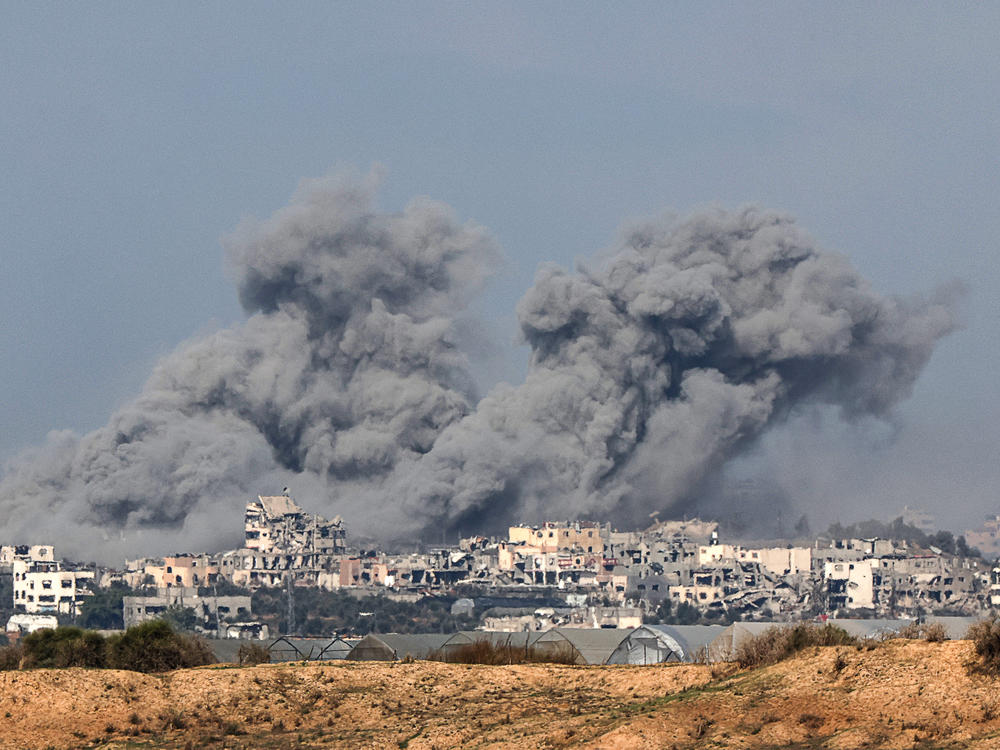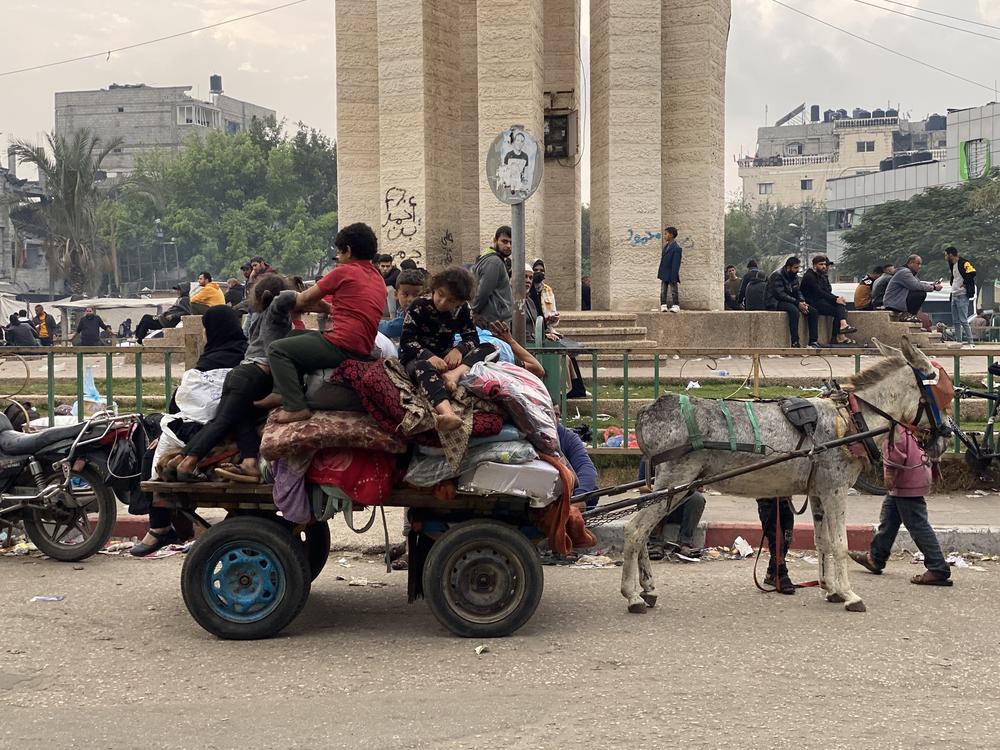Section Branding
Header Content
Israel says it is engaged in the heaviest fighting yet in Gaza
Primary Content
Updated December 6, 2023 at 7:45 AM ET
TEL AVIV, Israel — Some of the heaviest fighting since the start of Israel's air-and-ground assault on Gaza was taking place Wednesday in Khan Younis, with artillery shelling and gunfire echoing through the Palestinian territory's second-largest city.
But combat operations were also continuing in Gaza's north, the focus of Israel's first phase of the war that Israel says is aimed at crushing Hamas.
"We are in the heart of Jabaliya, in the heart of Shujaiya, and now also in the heart of Khan Younis," the head of Israel's Southern Command, Maj. Gen. Yaron Finkelman, said at a news briefing on Tuesday. Jabaliya, the site of a major refugee camp, and Shujaiya, are located in Gaza's north. Khan Younis, considered a Hamas stronghold, is located toward the south end of the Strip.
In Khan Younis, the reputed home of the Islamist militant group's top leader, Yahya Sinwar, Finkelman said senior Hamas leaders were being "eliminated."
He said the Israel Defense Forces on Tuesday were taking part "in the most intense day since the beginning of the ground operation, in terms of terrorists killed, the number of firefights, and the use of firepower from the land and air."
He said Israeli soldiers were "destroying weaponry and terrorist infrastructure, both above and below ground."
The statement marks the first time that Israel has acknowledged that ground forces are engaged in and around Khan Younis. Israel also released video it said showed soldiers operating in northern Gaza.
In a post on X (formerly Twitter), the IDF said on Wednesday that Israel's air force had hit 250 targets in the Gaza Strip in the past 24 hours, and that ground troops "continue to locate and destroy weapons, underground shafts, explosive charges and other terrorist infrastructures."
The fighting has forced hundreds of thousands of Palestinian civilians to flee or risk death. They are warned by Israel's military, using robocalls, online maps and leaflets dropped by airplanes, to move to "safer zones." The areas considered relatively free from fighting include a tiny sliver of coastal land known as Al Mawasi, and the Rafah area along the Egyptian border.
Bilal Shbeir, an English teacher who survived Israeli strikes around his home in central Gaza, says the last two days of the conflict have been "the toughest, the hardest, the most difficult."
"We have never had this before," he told NPR.
Many Palestinians who have fled south to Rafah sat in the streets, not quite sure where to stay. Mustafa, who gave only his first name when interviewed, blamed Hamas for not securing shelter for residents before waging war.
"A shattering, devastating humanitarian situation"
Speaking to NPR's Morning Edition, Mirjana Spoljaric Egger, the president of the International Committee of the Red Cross, who has just returned from a visit to Gaza, said what she saw there "is a shattering, devastating humanitarian situation, and the conditions are such that inadequate humanitarian response will not be possible if the situation persists."
Spoljaric said that due to the fighting, "our operating space is shrinking. So we have very limited mobility at the moment."
"There are very few remaining hospitals and the surgical teams are working around the clock," she said. "But there is no surgical capacity in many parts of Gaza, so people have to move for long distances and this is extremely dangerous given the heavy wounds that they are suffering."
UNRWA, the United Nations relief agency that aids Palestinians, issued yet another in a long series of dire warnings in recent days. It warned of "[another] wave of displacement" in Gaza.
"[T]he situation is getting worse each minute. There is no 'safe' zone, the entire Gaza Strip has become one of the most dangerous places in the world. There is nowhere to go as shelters, including UNRWA are overflowing," the agency said on X.
The United Nations has estimated that 80% of Gaza's 2.3 million people have been internally displaced by the fighting since Oct. 7, when Hamas carried out a surprise attack on communities in southern Israel, killing 1,200 people and taking around 240 hostages, Israel says. In response, Israel launched airstrikes and in the following weeks, a full-scale ground invasion of Gaza.
More than 16,000 people in Gaza have been killed since the fighting began, according to Gaza health officials, and nearly three-quarters of the population has been displaced. International pressure over the death and suffering inflicted on Gazans has led to growing calls for Israel to better protect Palestinian civilians.
Just since the collapse of a temporary truce last week, more than 1,200 Palestinians have been killed, according to Gaza's health ministry. Israel says 13 soldiers have been killed in the renewed combat operations.
Last week, U.S. Secretary of Defense Lloyd Austin gave a speech at the Reagan National Defense Forum in California, warning that Israel risks "strategic defeat" if it doesn't protect Palestinians in Gaza.
"The center of gravity is the civilian population and if you drive them into the arms of the enemy, you replace a tactical victory with a strategic defeat," Austin said.
Israel's Chief of Staff Herzi Halevi said Tuesday that, "We act professionally [and] evacuate the population ahead of time from the battle zones."
"We are asked a lot about the destruction in Gaza," Halevi said. "Hamas is the [answer] to those questions," adding, "Our forces find weapons in almost every house, terrorists are found in many houses, we fight them."
"These things require the use of a wide range of fire, both to damage the enemy and, of course, to protect our forces. That is why they operate powerfully" while still going to "great efforts to minimize harm" to civilians, Halevi said.
Brian Carter, an analyst with the Washington, D.C.-based Critical Threats Project, which has been tracking the urban fighting in Gaza, says Israeli forces have not been making fast progress on the ground.
"Clearing operations take a very long time," Carter said. "In areas they have already cleared they still have to conduct military operations as Hamas fighters attack their positions in these cleared areas."
A tense meeting with released hostages
Meanwhile, Prime Minister Benjamin Netanyahu and ministers of his war cabinet met with several hostages who were released after being held for weeks in Gaza by Hamas.
The released hostages castigated the Israeli government officials for claiming to have intelligence on Hamas locations yet bombing indiscriminately. They said during captivity they were more afraid of Israeli bombs than their militant captors.
One of the former hostages berated officials over reports that Israel was considering flooding Hamas tunnels, where many of the captives have been held.
Copyright 2023 NPR. To see more, visit https://www.npr.org.


